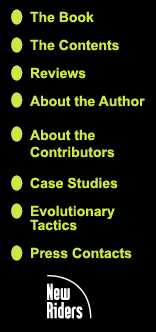

| Foreword for E-Volve-or-Die.com September 5, 2000 By Jim Sterne, President, Target Marketing When asked for examples of truly great customer service, one of my seminar attendees told the story of a recent visit to Amazon.com. He recounted how easy it was to find the book he wanted... how easy it was to make the purchase... how delighted he was when the item actually showed up on his doorstep the very next day. Another participant pointed out how sad it was that he was delighted because a company he was doing business with made a promise and actually stuck with it. The rest of us chucked, but then realized our level of expectation in most stores is rather low. Our online expectations are considerably higher. You've been thinking about and working on your Web site and Internet integration for years, but don't expect to see the end of the tunnel any time soon. The competitive landscape continues to change at a dizzying pace. E-Volve-or-Die.com gives you a current bird's-eye-view of the lay of the land - something you are going to need to keep up with customer expectations. Keeping your customers no longer rests in their willingness to stay with you out of blind loyalty or inertia. Consumers and business buyers are becoming more and more sophisticated and getting used to better and better service. People are expecting instant access to:
Customers know that you keep information about them in computers. The expectation is your computers can talk to each other and customers can access every bit of account information.
Expectations continue to rise dramatically. If you have a real-time database with all that information in it, customers expect you to have a Web server capable of fetching that information and dynamically delivering it at the click of a mouse.
What do you mean I can't find out on your Web site? What do you mean you haven't linked your Web site to your back-end corporate datacenter? I can get that information 24 hours a day, seven days a week from your competitor... Chapter Eight: New Expectations for Customer Service zeros in on this Customer Expectation Inflation and how online customer service has moved from a unique, new feature to a competitive necessity. Learn what you need to do within your company change manage new customers expectations and evolve your company. In October, 1998, Ford Motor Company put out a memo to its suppliers that was pure Back-to-the-Future. Allow them to buy supplies and raw materials over the Internet by June 1999, said the memo, or they would take their business elsewhere. Companies like Snap-On, the makers of high-end hand and power tools woke up and smelled more than 10% of their income at risk. It was time to move from curious to serious about the Web. Making your company easier to do business with is today's great competitive edge. Customers expect the best price. They expect fast service. They expect to get answers instead of being put on hold until dawn. They will flock to buy from you if you can save them ten minutes here, and twenty minutes there. Take a moment to look at your competitors' efforts on the Web. Take a moment every week. It's the only way you're going to stay ahead of the game. What can you offer than your competitors cannot? If you can't improve your products any more and you can't lower your price anymore--you can only improve your service. Why do your customers need service twenty-four hours a day, seven days a week? Because that's when they're working. Engineers, operations managers, human resource workers, marketing executives and others have always burned the midnight oil to finish projects. More and more virtual corporation partners are working at home and getting on-line after the kids are asleep. These people need answers at all hours, not just nine to five and certainly not just in your time zone. Successful customer service always means looking at your products, your company, and your customer service methods through your customers' eyes. The customer doesn't care if your company is organized by product line, business unit or spheres of political influence. The customer wants his or her question answered or problem solved, and solved now. The most important task for a customer service Web builder to undertake is figuring out what the customer will want to see, want to learn, and want to get out of the experience **every time they contact your company**. Chapter Four: Customer Touch Points, offers insight into capturing the attention of your customers and walks through the five phases of customer/company interaction. Customers are starting to get accustomed to CRM (customer relationship management) and are expecting you to provide more and more and better and better service. Whether you outsource the touch point, you can't lose control of your customer interactions. How do you continue to cater to customers on an ongoing basis? It may be well worth the effort to ask them directly, "As you do business with us via our Web site, what additional information would you like us to show? What functionality would you like us to add?" As your and your competitor's Internet integration continues, your customers are going to have higher and higher expectations. You'll need to stay one step ahead of them. You need to E-Volve-or-Die. Jim Sterne |
